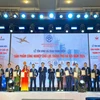Vietnam will have at most 150 rice exporters with close connection with major production areas by 2015, according to the Ministry of Industry and Trade (MoIT).
The figure was announced during a conference on rice export and exporter management in Ho Chi Minh City on September 10.
At the conference, Phan Van Chinh, head of the Import-Export Department under the MoIT, said that exporters must meet three main criteria to receive licences to export rice.
They must have rice storage and rice husking mills located in localities included in the planned areas.
Exporters having their own raw material areas or work with partners to order and buy rice from farmers will be prioritised, he said.
In addition, Chinh said exporters must meet requirements of export volume, material areas and connectivity with farmers in order to maintain their export licences.
According to Deputy Minister Tran Tuan Anh, the world rice export market has seen an increasing supply and many new markets have appeared, affecting Vietnamese exports.
He said in the next months, the global rice market will continue facing difficulties with high inventory, making exporting countries let out their stockpile.
The situation requires Vietnamese exporters to carefully and accurately evaluate the market demand to find suitable solutions, he added.
During the event, authorities from the MoIT suggested a number of measures to manage rice export such as strengthening domestic linkages and collaboration in line with national promotion programmes, and seeking new markets.-VNA
The figure was announced during a conference on rice export and exporter management in Ho Chi Minh City on September 10.
At the conference, Phan Van Chinh, head of the Import-Export Department under the MoIT, said that exporters must meet three main criteria to receive licences to export rice.
They must have rice storage and rice husking mills located in localities included in the planned areas.
Exporters having their own raw material areas or work with partners to order and buy rice from farmers will be prioritised, he said.
In addition, Chinh said exporters must meet requirements of export volume, material areas and connectivity with farmers in order to maintain their export licences.
According to Deputy Minister Tran Tuan Anh, the world rice export market has seen an increasing supply and many new markets have appeared, affecting Vietnamese exports.
He said in the next months, the global rice market will continue facing difficulties with high inventory, making exporting countries let out their stockpile.
The situation requires Vietnamese exporters to carefully and accurately evaluate the market demand to find suitable solutions, he added.
During the event, authorities from the MoIT suggested a number of measures to manage rice export such as strengthening domestic linkages and collaboration in line with national promotion programmes, and seeking new markets.-VNA



















